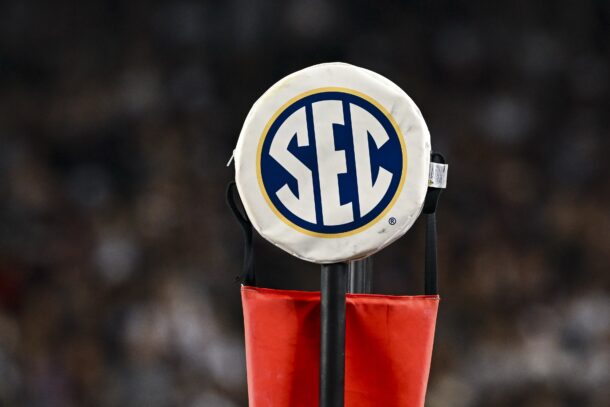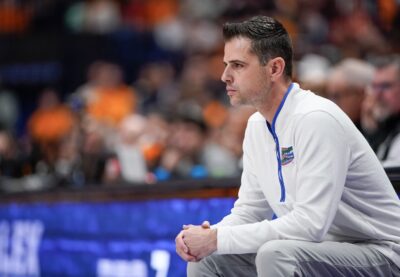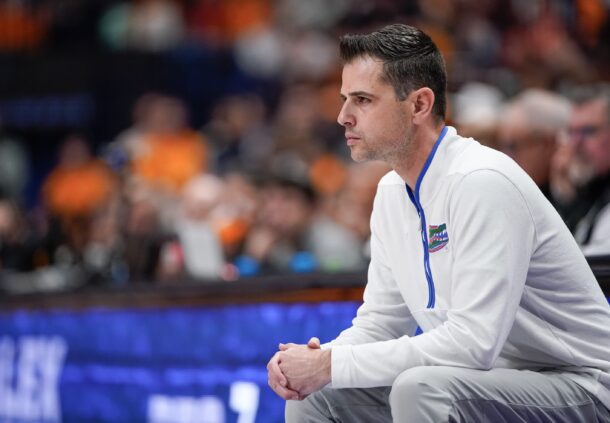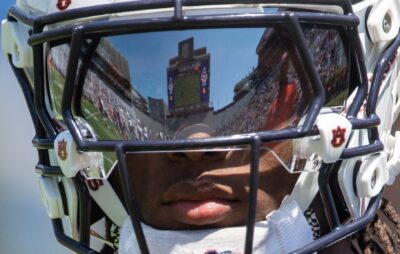Ad Disclosure
Dollars and Sense: How greed and the players’ pursuit of fairness are fueling college football’s mad dash for cash
By Matt Hayes
Published:
College football starts in earnest Thursday night, opening a 5-day made-for-TV football bonanza. College football is a cut-throat, billion-dollar business. This battle for cash has led to conferences raiding one another and created 9-figure, fully-guaranteed coaching salaries. Almost everybody has benefited. Almost.
Now, the players want their share.
And that’s going to change everything …
DESTIN, Fla. — Of course it went virtually ignored. Because like every other major crossroad in the history of collegiate sports, the overall health of the engine is drowned out by the squeaky wheel.
Or in this case, Alabama coach Nick Saban and Texas A&M coach Jimbo Fisher bickering over the definition of “bought” during the SEC’s annual spring meetings.
Meanwhile, at the same meeting, Florida coach Billy Napier said it’s time to play players.
Not name, image and likeness money. Straight pay-for-play — the longtime unforgivable sin of amateur sports.
“It all leads back to the money,” Napier said.
Everything revolves around media rights and NIL money. Every decision moving forward, every potential obstacle. Every political intervention, every legal argument. Every interaction between player and coach, and player and player.
Every winner and every loser is touched by the intoxicating green temptress that is big money.
Coaching salaries and player salaries. Player procurement and roster management. The postseason and potential conference expansion. NCAA governance restructuring and a deepening gap between the have and have-nots.
Pay-for-play is simply the final move on the chessboard.
“NIL is the crisis now,” a Big Ten athletic director said on the condition of anonymity. “But NIL is a ripple compared to the title tidal wave that’s coming.”
How big is that wave? Big Ten commissioner Kevin Warren publicly said earlier this month — weeks after his conference formally added USC and UCLA and is potentially moving to 20 teams in the future — that pay-for-play is coming. And he wants the Big Ten to be at the forefront.
In a matter of months, the Big Ten presidents have shifted from the protector of all that is evil threatening the grand game to a pedal-to-the-metal, wide-open sprint into the great unknown.
It wasn’t long ago that the Big Ten found two conference colleagues who were desperate enough to believe in something called an Alliance of the Big Ten, ACC and Pac-12. Less than a year later, the Big Ten stabbed the Pac-12 in the back, stealing its greatest money-making properties to land the exclusive Los Angeles television market.
Warren went from decrying the state of college athletics after Texas and Oklahoma joined the SEC to oafishly boasting about a new frontier of college football after accepting USC and UCLA — and how the Big Ten would lead the way.
“We are living in a world where sport mirrors politics,” a Group of 5 conference commissioner told SDS. “You say whatever you want, and it doesn’t matter if it’s a bald-faced lie because no one is held to it. So you say and do whatever you want, even to the detriment of others, and eventually, to yourself.”
You’ve no doubt seen the video on YouTube of a 50-foot wave, and a surfer — but a speck on the video — screaming down the breaking tide and wobbly ripping through the water in a mad dash to outrun impending annihilation. The wall breaks everywhere, the surfer can’t be seen.
College football is that surfer, everyone. By its own greedy doing.
The question is: Can it survive the mad run for cash down the 50-foot wave and continue to strengthen a unique and valuable product?
Power struggle for billions … with a b
That foundation of paradigm change in college football is the billion-dollar media rights deals structured all over college sports. The SEC/ESPN deal begins in 2024, and once escalator clauses are executed with the addition of Texas and Oklahoma, will pay at least $1.5 billion annually to the conference through 2034.
The Big Ten’s new deal with Fox, CBS and NBC is worth an estimated $1.5 billion annually through the 2029 football season and has an escalator clause when new universities are added to the conference.
Even the Pac-12, long trailing the field in media-rights cash, could have a new 2024 media rights deal set by the end of the year that an industry source says will be worth over “half a billion annually” — if the league stays at 10 teams (after losing USC and UCLA).
If it doesn’t, and the Big Ten and/or SEC raid the Pac-12, the terms of that deal will change. Multiple industry sources have told SDS that Washington, Oregon, Stanford and California are not signing long-term commitments to any new Pac-12 (or is it now Pac-10 again?) media rights deal.
“When you look at the numbers, it’s embarrassing. There’s value to a scholarship, and giving them the facilities and coaching, and nutrition and training, to get them ready for a professional career. But boy, it’s hard to ignore those numbers when you lay it out like that.” — a Power 5 athletic director told SDS
The only media rights deal they will sign will come with an out clause that won’t tie them (and their media rights) long-term to the conference. The Pac-12 has no choice if it wants to stay alive and must agree to the stipulation.
The ACC is in the middle of a media rights deal with ESPN through 2036, one that will pay upwards of $400 million annually. The Big 12 is currently in the process of negotiating a new deal, one that will pay it considerably less without Texas and Oklahoma — and multiple industry sources say it could fetch $400 million annually.
But the money doesn’t end there. The looming expansion of the College Football Playoff is the final feed at the trough.
Remember, the Alliance scuttled Playoff expansion a year ago to curb SEC power, using the facade of player safety, the academic calendar and the unknown of a 12-team format as a shield. A year later, after the Big Ten expanded in response to the SEC moving to 16 teams, the Big Ten, ACC and Pac-12 all jumped on Playoff expansion. Now.
Not at the end of the current deal after the 2025 season — but as soon as next season.
Not the 12-team format that was originally agreed upon before it was scuttled on the way to being rubber-stamped — but a 16-team format.
Why, you ask? Straight cash.
Or more to the point: an estimated $1.2 billion annually for 11 postseason games.
Now, the kicker: The new media rights deals for the Power 5 conferences, and the new Playoff deal, will push the annual media rights income toward more than $5 billion annually.
Meanwhile, players make as much as $5,500 a year in cost-of-attendance scholarship stipends. There are 11,135 scholarship players in FBS football.
If the $5,500 stipend is used for each of those scholarship players (the majority of FBS players earn much less than $5,500), the 11,135 scholarship players in FBS football earn $61,242,500 annually — or 1.25 percent of $5 billion.
“When you look at the numbers, it’s embarrassing,” a Power 5 athletic director told SDS. “There’s value to a scholarship, and giving them the facilities and coaching, and nutrition and training, to get them ready for a professional career. But boy, it’s hard to ignore those numbers when you lay it out like that.”
Make no mistake, this is a power struggle. Money fuels power, and power leads to change. And change — deep, significant, you’ll never recognize college football/sports again change — is closer than you think.
The only variable is time. In the summer of 2021, the United State Supreme Court ruled against the NCAA in an antitrust case limiting the NCAA’s rights to bar college athletes from getting paid. Shawne Alston, a former running back at West Virginia who had a cup of coffee in the NFL, was the lead plaintiff in the case.
The Supreme Court ruled in Alston vs. the NCAA that the NCAA violated antitrust laws, and should play players for “education-related” benefits — but did not rule on broader compensation questions. There are multiple cases currently in the system arguing compensation for players, and a rare 9-0 ruling by the Supreme Court on the antitrust laws has scared university presents straight.
Though not the official court opinion (written by Neil Gorsuch), Justice Brett Kavanaugh wrote a concurring opinion directly aimed at pay-for-play, suggesting NCAA rules that restrict any type of compensation — including “direct payment for athletic accomplishments” — may not hold up in future antitrust challenges.
He all but begged future cases to come forward and challenge pay-for-play.
“The NCAA is not above the law,” Kavanaugh wrote. “The NCAA couches its arguments for not paying student-athletes in innocuous labels. But the labels cannot disguise the reality: The NCAA’s business model would be flatly illegal in almost any other industry in America.”
‘It’s foolish to say players don’t deserve a piece of the pie’
The landmark ruling by the Supreme Court was a gut punch to the NCAA. It was also 10 days before the NIL floodgates officially opened.
“It’s no longer, if it’s going to happen; it’s when. Players will get paid. How much and how soon is the only question. — an SEC Athletic Director told SDS
Only weeks earlier, the NCAA announced a one-time free transfer rule, setting in place free movement of all players in all sports. Previously, football and basketball players were forced to sit out a year unless granted a waiver; most non-revenue athletes faced no such restrictions.
Combined with the mismanagement of NIL and the resulting wide-open market, the NCAA had developed de facto free agency for players.
The perfect storm had begun — and will only grow larger and more unwieldy until the NCAA gets its hands around pay-for-play.
“It’s no longer, if it’s going to happen; it’s when,” an SEC athletic director told SDS. “Players will get paid. How much and how soon is the only question. But we can’t drag our feet on this. We have to get ahead of it, or it could be worse than the NIL disaster.”
The NCAA had 21 months to figure out a system and standards for NIL — 21 months to prevent unintended consequences from infecting their product and damaging their brand.
Not only did the sport’s governing body not figure out a system, it made things exponentially worse with the transfer rule.
After more than 150 years of universities wielding the power in a wildly one-sided labor force, players finally moved closer to even ground with a true free agency system that professional sports could envy.
There’s a reason Napier chose that moment, in a spring meetings environment that typically ends with the SEC announcing its ever-increasing annual per school payout, to explain the “research” he worked on, and declare the role of pay-for-play moving forward.
A few weeks earlier, Ohio State athletic director Gene Smith suggested that major college football break away from the NCAA and operate under College Football Playoff rules — and with its own structure and enforcement. ACC commissioner Jim Phillips said in May that now may be the time to look for structural change within the sport.
Essentially, those who make the money make the rules.
That led the football coach at Florida to say the quiet words out loud at the SEC spring meetings. Napier, who makes more money annually ($7.1 million) than his president and athletic director combined, said it’s time players receive a percentage of the billions universities make from television media rights.
It took Napier less than a minute to encapsulate the history and future of college football — and the dangerous road that lies ahead.
“If you go back to 1990, each SEC institution got $1.3 million a year from the league,” he said. “Now 13 years ago, it was right around ($17) million. Then this 2024 (media rights) deal is in the high $60s-$70s.”
Coaches’ salaries have surged, too. In 2010, just 7 FBS head coaches made more than $3 million annually, according to USA Today’s annual database. In 2021, 11 SEC football coaches made more than $4 million annually. Everybody’s benefitting. Well, almost everybody.
Napier paused for a moment, then persisted to explain the single most important paradigm change facing collegiate sports.
“One of the things about my career is I’ve been in the profession and I’ve observed this explosion,” said Napier, a star quarterback at FCS Furman in the early 2000s. “I think it’s foolish to say the players don’t deserve a piece of the pie. If there’s no players in these stadiums, fans are certainly not showing up to watch. And they’re not sitting in their homes watching it on television.”
Growing closer to the NFL revenue-split model
The cost of the groundbreaking change is immeasurable. Nearly one year later, there are no NIL standards, no rules, no limitations.
“It’s like you’re standing in front of a fire hydrant and they turn it on full blast,” North Carolina coach Mack Brown said. “The problem is, they don’t know how to shut it off and there are no directions. And now it’s up to us as coaches to find a way to stay dry.”
The result of this haphazard ignition should come as no surprise. The NCAA may as well have thrown kerosene on a grease fire.
NFL players receive about 48-49 percent of the media rights revenue. As it is now, college football players receive 1.25 percent of the projected $5 billion annually in media rights revenue
In one agonizingly slow, 21-month NIL capitulation, the NCAA opened the door to the boogeyman they’ve desperately tried to keep at bay for decades: booster involvement in recruiting.
Collectives formed, boosters fueled silos with millions in cash, and within months, a full-fledged, above-board pay-for-play arms race had developed — for players currently enrolled, and more damaging to the health and competitive balance of the sports, for high school players.
Collectives are combing the lists of top high school players to pay for their services, roaming the recruiting streets with near-complete immunity. In a span of one year, college football has gone from limited player movement and zero player financial earning power, to free movement and the ability to negotiate any financial contract of any amount.
“I don’t know that we were ever in this place that we wanted to see amateurism so distorted that it would move toward professionalism,” LSU coach Brian Kelly said. “I’m interested in developing something that’s sustainable, something we can educate players on, and something equitable across the board. But this has turned into a runaway train that has moved well past student-athlete and is moving too fast toward professional contract.”
Now, the problem: It’s going to get much worse before it gets better. Because currently, not one penny flows from the universities to players. NIL deals are made without the input (financial and otherwise) of universities.
The NCAA has no control over NIL deals, and has resorted to asking member institutions to turn each other in when they have proof of “tampering” and “recruiting inducements” and “impermissible benefits.” But a lack of detailed and uniform rules has made it nearly impossible to enforce violations.
Straight pay-for-play, on the other hand, will come directly from university coffers because it will be paid with media rights revenue.
Think about this: The NFL makes $10 billion annually with its current media rights deal. Players, through a players association and a collectively bargained agreement, receive about 48-49 percent of the media rights revenue.
As it is now, college football players receive 1.25 percent of the projected $5 billion annually in media rights revenue — with no players association and no collective bargaining agreement.
“The problem with the NCAA is they continue to throw good money after bad,” an industry source told Saturday Down South. “They’ve lost critical (court) battles to preserve their amateur model that isn’t recognizable anymore. Some want to dig in and fight more and are willing to spend hundreds of millions in legal fees to try. Others see the writing on the wall.
“They better get ahead of it before they don’t have control of it.” Before it becomes another NIL fire hydrant.
Will the bubble burst?
One NCAA source told Saturday Down South that there is hope the open market takes care of NIL instability and booster influence. It’s simple economics in the short term.
NIL has created a “bubble” of sorts in the collegiate sports economy, not unlike the dotcom “bubble” of two decades ago where a “bubble” in the stock market was caused by speculation of internet-related companies.
The unbridled NIL world is full of speculators (collectives) investing in the unknown of high school recruits.
“Eventually,” the NCAA source said, “it will even out.”
Eventually, the “bubble” will burst when boosters funding collectives don’t see an equitable rate of return on their investment.
But even that perfect-case scenario for universities won’t slow the surge of current college players leaving schools for better NIL deals at other universities. That NIL money likely will never dry up.
In that sense, the one-time free transfer rule has had as much impact as players earning off their NIL. And when the two are combined, it’s program-defining — or program-deflating.
That reality quickly came into focus when Lincoln Riley left Oklahoma to coach USC. No other school can offer its athletes greater NIL potential than USC. The Trojans are a top-5 program surrounded by the glam and glitz of Los Angeles — with the hundreds of millions of untapped NIL funds and the pull of Hollywood. Riley went to work as soon as he arrived on campus, stealthily picking prize players once they entered the portal.
Riley got the most coveted transfer quarterback (Caleb Williams, Oklahoma) and tailback (Travis Dye, Oregon), the top two wideouts (Jordan Addison, Pitt; Mario Williams, Oklahoma), and the top linebacker (Eric Gentry, Arizona State) in the transfer portal.
In four months, Riley reshaped the USC roster and immediately turned the Trojans into a Pac-12 favorite.
“We’ll figure out NIL. I don’t know any coach who isn’t all for players having the ability to earn,” Syracuse coach Dino Babers said. “The transfer portal, that’s a different story. We haven’t even begun to take into account how it affects scholarship count, APR scores, the recruiting calendar. It’s all just out there, with no real guidelines.”
Everything is on the table
NCAA officials always thought NIL would be a get out of jail free card, a unique way to circumvent pay-for-play.
In 2010, just 7 FBS head coaches made more than $3 million annually, according to USA Today’s database. In 2021, 11 SEC football coaches made more than $4 million annually.
Initially, the idea was NIL would be an avenue to avoid Title IX lawsuits, while allowing all student-athletes in all sports to earn. The free market would dictate who earns and who doesn’t.
The problem: free market means free market — and that means high school recruits are fair game, too.
The entire system is upside down, its original intent to reward college athletes to earn after positioning themselves for NIL deals through their play on the field. Again, the belief within the NCAA is the Wild West mentality will eventually even out.
When it does, pay-for-play comes into focus. There’s too much money being made by too many universities to not find a way for the players to receive a percentage.
The days of a 5-year scholarship, training and development and a $5,500 stipend as fair trade — despite the inherent value in all — are long gone. When the updated media rights deals and new Playoff deal combine to generate an estimated $5 billion annually, there’s nowhere to hide in the pay-for-play argument.
When asked how the NCAA can argue against that bloated, multi-billion-dollar media-rights number in court, an ACC athletic director told SDS, “There are clearly ways, but considering what we’ve already heard from (the Supreme Court), it will be a heavy lift.”
That’s why Smith and Phillips (and they’re not alone) are talking about restructuring the system and pointing it toward schools that invest in football being allowed to govern themselves.
That includes conference membership, rules enforcement, regular season and postseason structure. Sankey, for instance, suggested this spring that the SEC isn’t opposed to forming an SEC-only Playoff, which an industry insider said could be worth $600 million annually.
The ever-changing landscape also includes pay-for-play. Don’t think of pay-for-play as an NFL structure, where the best players get the majority of the money.
Think of it more as an expansion of the current cost of attendance stipend. For example, if a player currently makes $5,500, that number could be tripled to $16,500. Or more, depending on each school’s ability to generate revenue and increase the stipend.
If players receive 10 percent of the estimated $5 billion annually, that’s $500 million. That means $44,903 for each of the 11,135 FBS scholarship players.
The NFL recently distributed $249 million per team from its 11-year, $111 billion media rights deal. SEC and Big Ten teams will earn nearly $80 million annually or about 30 percent of what an NFL franchise made in 2021.
The NFL salary cap in 2021 was $182.5 million per team.
In nearly every Power 5 school, football and men’s basketball are the only money-makers. That’s 98 total scholarships (85 for football, 13 for basketball) that pay for themselves — and every other sport.
Less than 100 student-athletes per school are responsible for a large majority of the nearly $80 million annually in media rights money in the SEC and Big Ten.
“No matter what you think of how the sausage is made, those are the numbers that will be argued in (future court) cases,” a Big Ten athletic director said. “That’s what we’re staring at.”
That’s the tidal wave. The FBS schools better get out in front it. Before they lose control of it.
Matt Hayes is a national college football writer for Saturday Down South. You can hear him daily from 12-3 p.m. on 1010XL in Jacksonville. Follow on Twitter @MattHayesCFB




